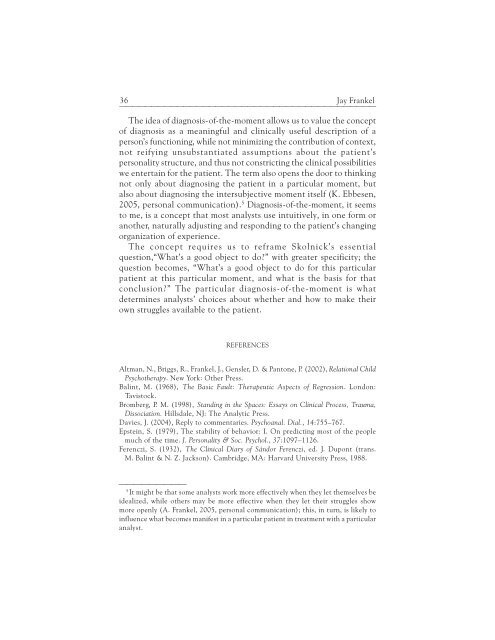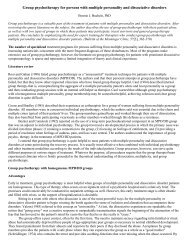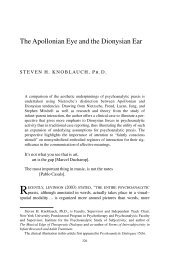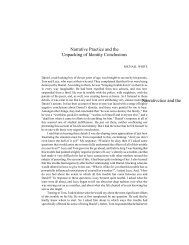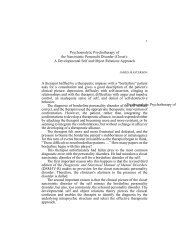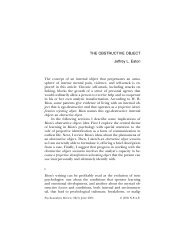What's a Good Object to Do? - PsyBC
What's a Good Object to Do? - PsyBC
What's a Good Object to Do? - PsyBC
You also want an ePaper? Increase the reach of your titles
YUMPU automatically turns print PDFs into web optimized ePapers that Google loves.
36 Jay Frankel<br />
⎯⎯⎯⎯⎯⎯⎯⎯⎯⎯⎯⎯⎯⎯⎯⎯⎯⎯⎯⎯⎯⎯⎯⎯⎯⎯⎯⎯⎯⎯⎯⎯⎯⎯⎯⎯⎯⎯⎯⎯<br />
The idea of diagnosis-of-the-moment allows us <strong>to</strong> value the concept<br />
of diagnosis as a meaningful and clinically useful description of a<br />
person’s functioning, while not minimizing the contribution of context,<br />
not reifying unsubstantiated assumptions about the patient’s<br />
personality structure, and thus not constricting the clinical possibilities<br />
we entertain for the patient. The term also opens the door <strong>to</strong> thinking<br />
not only about diagnosing the patient in a particular moment, but<br />
also about diagnosing the intersubjective moment itself (K. Ebbesen,<br />
2005, personal communication). 5 Diagnosis-of-the-moment, it seems<br />
<strong>to</strong> me, is a concept that most analysts use intuitively, in one form or<br />
another, naturally adjusting and responding <strong>to</strong> the patient’s changing<br />
organization of experience.<br />
The concept requires us <strong>to</strong> reframe Skolnick’s essential<br />
question,“What’s a good object <strong>to</strong> do” with greater specificity; the<br />
question becomes, “What’s a good object <strong>to</strong> do for this particular<br />
patient at this particular moment, and what is the basis for that<br />
conclusion” The particular diagnosis-of-the-moment is what<br />
determines analysts’ choices about whether and how <strong>to</strong> make their<br />
own struggles available <strong>to</strong> the patient.<br />
REFERENCES<br />
Altman, N., Briggs, R., Frankel, J., Gensler, D. & Pan<strong>to</strong>ne, P. (2002), Relational Child<br />
Psychotherapy. New York: Other Press.<br />
Balint, M. (1968), The Basic Fault: Therapeutic Aspects of Regression. London:<br />
Tavis<strong>to</strong>ck.<br />
Bromberg, P. M. (1998), Standing in the Spaces: Essays on Clinical Process, Trauma,<br />
Dissociation. Hillsdale, NJ: The Analytic Press.<br />
Davies, J. (2004), Reply <strong>to</strong> commentaries. Psychoanal. Dial., 14:755–767.<br />
Epstein, S. (1979), The stability of behavior: I. On predicting most of the people<br />
much of the time. J. Personality & Soc. Psychol., 37:1097–1126.<br />
Ferenczi, S. (1932), The Clinical Diary of Sándor Ferenczi, ed. J. Dupont (trans.<br />
M. Balint & N. Z. Jackson). Cambridge, MA: Harvard University Press, 1988.<br />
⎯⎯⎯⎯⎯⎯⎯⎯⎯<br />
5<br />
It might be that some analysts work more effectively when they let themselves be<br />
idealized, while others may be more effective when they let their struggles show<br />
more openly (A. Frankel, 2005, personal communication); this, in turn, is likely <strong>to</strong><br />
influence what becomes manifest in a particular patient in treatment with a particular<br />
analyst.


